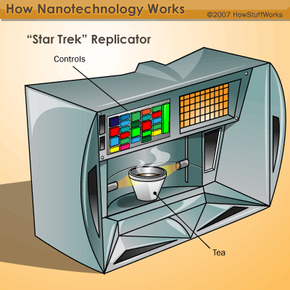The Future of Nanotechnology
In the world of "Star Trek," machines called replicators can produce practically any physical object, from weapons to a steaming cup of Earl Grey tea. Long considered to be exclusively the product of science fiction, today some people believe replicators are a very real possibility. They call it molecular manufacturing, and if it ever does become a reality, it could drastically change the world.
Atoms and molecules stick together because they have complementary shapes that lock together, or charges that attract. Just like with magnets, a positively charged atom will stick to a negatively charged atom. As millions of these atoms are pieced together by nanomachines, a specific product will begin to take shape. The goal of molecular manufacturing is to manipulate atoms individually and place them in a pattern to produce a desired structure.
Advertisement
The first step would be to develop nanoscopic machines, called assemblers, that scientists can program to manipulate atoms and molecules at will. Rice University Professor Richard Smalley points out that it would take a single nanoscopic machine millions of years to assemble a meaningful amount of material. In order for molecular manufacturing to be practical, you would need trillions of assemblers working together simultaneously. Eric Drexler believes that assemblers could first replicate themselves, building other assemblers. Each generation would build another, resulting in exponential growth until there are enough assemblers to produce objects [source: Ray Kurzweil].
Trillions of assemblers and replicators could fill an area smaller than a cubic millimeter, and could still be too small for us to see with the naked eye. Assemblers and replicators could work together to automatically construct products, and could eventually replace all traditional labor methods. This could vastly decrease manufacturing costs, thereby making consumer goods plentiful, cheaper and stronger. Eventually, we could be able to replicate anything, including diamonds, water and food. Famine could be eradicated by machines that fabricate foods to feed the hungry.
Nanotechnology may have its biggest impact on the medical industry. Patients will drink fluids containing nanorobots programmed to attack and reconstruct the molecular structure of cancer cells and viruses. There's even speculation that nanorobots could slow or reverse the aging process, and life expectancy could increase significantly. Nanorobots could also be programmed to perform delicate surgeries -- such nanosurgeons could work at a level a thousand times more precise than the sharpest scalpel [source: International Journal of Surgery]. By working on such a small scale, a nanorobot could operate without leaving the scars that conventional surgery does. Additionally, nanorobots could change your physical appearance. They could be programmed to perform cosmetic surgery, rearranging your atoms to change your ears, nose, eye color or any other physical feature you wish to alter.
Nanotechnology has the potential to have a positive effect on the environment. For instance, scientists could program airborne nanorobots to rebuild the thinning ozone layer. Nanorobots could remove contaminants from water sources and clean up oil spills. Manufacturing materials using the bottom-up method of nanotechnology also creates less pollution than conventional manufacturing processes. Our dependence on non-renewable resources would diminish with nanotechnology. Cutting down trees, mining coal or drilling for oil may no longer be necessary -- nanomachines could produce those resources.
Many nanotechnology experts feel that these applications are well outside the realm of possibility, at least for the foreseeable future. They caution that the more exotic applications are only theoretical. Some worry that nanotechnology will end up like virtual reality -- in other words, the hype surrounding nanotechnology will continue to build until the limitations of the field become public knowledge, and then interest (and funding) will quickly dissipate.
In the next section, we'll look at some of the challenges and risks of nanotechnology.
